PDF of this article (289 KB)
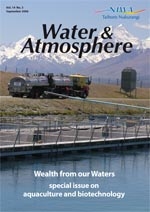

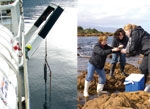
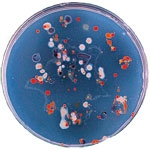
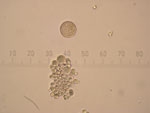
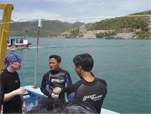
Tiny, yet supremely adaptable, marine bacteria promise to be the next great source of new biotechnology products. Els Maas leads research into potential uses of these micro-organisms in products as diverse as washing powders and anti-cancer drugs.
Marine bacteria are found throughout the oceans, from the seafloor to the insides of fish stomachs. Far from being a uniform environment, their ocean home contains many distinct habitats, such as deep-sea sediments, underwater mountains (seamounts), and even the outside of an algal cell. These bugs have developed unique mechanisms to survive diverse conditions, including very salty to merely brackish water, and temperatures ranging from 35°C in tropical waters to –5°C in the polar and deep-sea waters. It’s these unique survival mechanisms that make marine bacteria so promising as a source of new biologically active substances, with potential uses in industrial processing, medicines, and foods.
The power of enzymes
Our hunt for useful industrial enzymes has taken us inside the stomachs of some common fish species. It’s here that we find bacteria that produce enzymes that breakdown fat (lipases), protein (proteases), and carbohydrate (amylases). Growing these bacteria on agar plates in the laboratory, we found up to 1 million bacteria in each gram of fish stomach contents. The challenge now is to harness these bacteria in commercial applications. This could include incorporating them into aquaculture feeds to help farmed fish get the maximum energy out of their food, or using the lipases in washing powders to break down food stains.
Recently, we’ve also isolated bacteria from deep-sea mud, using the sediment corer onboard NIWA’s deepwater research vessel Tangaroa. We were able to retrieve bacteria from as deep as 4 km below the sea surface and get them to survive at sea level. We will be exploring these bacteria for unique enzymes that could be used in industrial processes, such as purifying chemicals for use in toiletries or to supply science laboratories.
New drugs from killer bugs
Marine bacteria hold great promise as a largely untapped source of new drugs. Land bacteria have already been proven as a source of drugs, such as penicillin. More recently, new antibiotics and anti‑cancer drugs have been identified from marine bacteria. For example, an antibiotic that fights tuberculosis (TB) has been found in two species of Pseudomonas bacteria isolated from a marine alga and a tube worm.
Marine bacteria are thought to produce antibiotics in response to competition. Food is scarce in the oceans, so bacteria that can reduce the competition by killing their neighbours are more likely to survive. Consequently, marine bacteria have developed a wide range of antibiotics. New Zealand’s marine bacteria have not yet been screened for new antibiotics, but this is something NIWA plans to do.
We have already identified anti-cancer agents in marine bacteria, and our tests suggest there may be more out there. Out of 330 marine bacteria we screened, 7% were able to stop the growth of cancer cells. The compounds that the bacteria produce are very specific in stopping the growth of lung cancer cells and do not affect healthy cells. We’re currently trying to work out what the actual compounds are so that we can develop them further.
Food from bugs
Omega-3 oils are found in oily fish, such as tuna, and have demonstrated a variety of health benefits, including improved brain function, and reduced risk of heart attack. A wide range of marine organisms produce omega-3s, including micro‑algae, bacteria, fungi, yeasts, and thraustochytrids (a special class of fungus-like micro-organisms). The benefit of using these types of organisms – especially the thraustochytrids, fungi, and bacteria – is that they are easy to grow, and their omega-3s are free of fishy smells, heavy metals, and other impurities often found in fish oils.
The biggest market for omega-3s is in baby milk formula. However, baby fish also need this vital nutrient in their diets to ensure normal growth and development. In the last year, NIWA has begun a new search for native thraustochytrids that can provide a source of omega-3s and other valuable food ingredients.
Our research has so far shown that marine bacteria produce a range of interesting and useful compounds. We already hold some 2000 bacterial isolates and continue to find new marine bacteria that have not been seen anywhere else in the world. We are confident that there are a lot more useful discoveries to be made from New Zealand’s ocean bugs.
Benefits from bugs
- Marine bacteria survive in a wide variety of environments and they produce a range of interesting and useful compounds.
- Some marine bacteria make enzymes that can be used to enhance feeds or improve washing powder.
- Others are the source of antibiotics and may help fight cancer.
Dr Els Maas is an environmental microbiologist at NIWA in Wellington. Read more about her work in this issue’s Profile. Contact Els at [email protected].
Teachers’ resource for NCEA AS: Biology 90718 (3.6) 90769 (2.2), 90168 (1.8), 90162 (1.2), Level 3 US6320, Level 2 US6310, Level 1 US6298, US18978 Science 90188 (1.3) See other curriculum connections at www.niwa.co.nz/pubs/wa/resources
